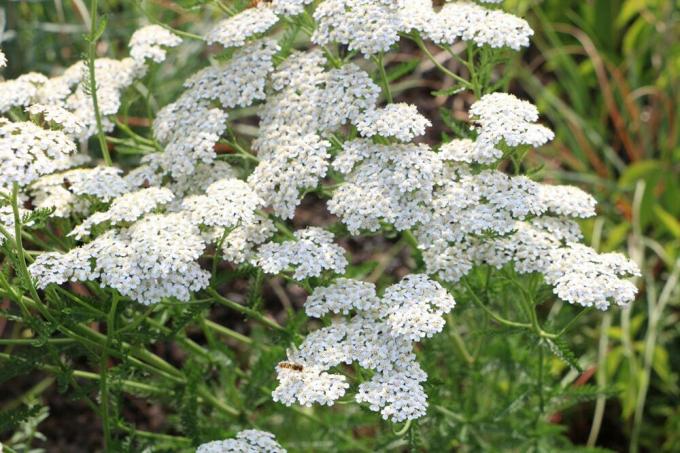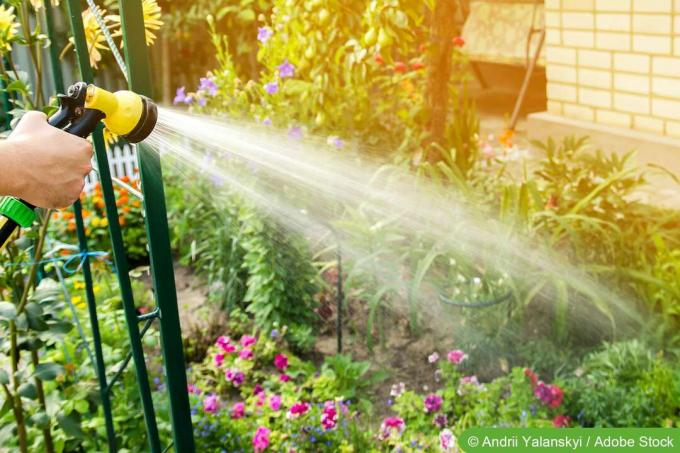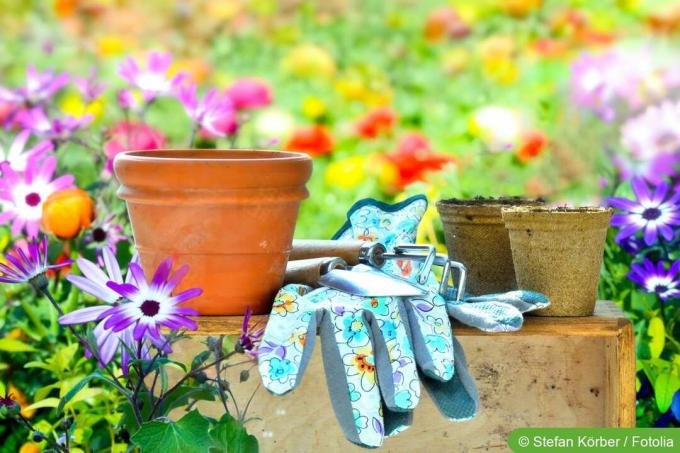

Table of contents
- Gardening in November
- More gardening tips for November
- fruit trees
- What to do with the autumn leaves?
- The garden – frost-proof and winterproof
- Overwinter potted plants
- roses and dahlias
- Time for winter vegetables
- Last work in November
Summer is finally coming to an end. This is not only noticeable in the cold, frosty temperatures, but also in the fact that the flowers in the garden, on the balcony and on the terrace are dwindling. Now it's time to tidy up and now it's time to make the garden, balcony and terrace winterproof. The last cut of the lawn is also due. In November, the hobby gardener has his hands full.
Gardening in November
- Potted plants that are not hardy should now be cut back and put away. Otherwise, the cold nights could cause serious tissue damage that could no longer be repaired. Everything withered must be cut off. If the soil in the pots is still too wet, the plants should first be protected from the rain for a few days (under a canopy, under the carport, etc.) so that the soil can dry out a bit. Too wet soil in the winter quarters can lead to severe root damage.
- The lawn needs to be cut short one last time. Leaves and other plant debris should be completely removed from the lawn to prevent mold growth. The ground under the lawn should and must remain permeable even in winter. A last fertilization is also helpful. After the last cut of the lawn, the lawnmower and the brushcutter should be winterized immediately. All equipment should come into the winter clean. It's better to do minor repairs now so that you don't have to waste time with them next spring.
- You should also use scissors in the perennial bed. Wilted perennials should be cut off. You can safely leave the remains of the blossoms of sedum. They are not only an ornament in the winter garden, they also protect the plants from cold and excessive moisture. Perennials where the seeds have not been removed can also be left standing, as they provide plenty of food for many birds.
- Plants planted in autumn should be protected somewhat in the first winter. To do this, you can pile up the plants in the root area with some soil, or protect them from the cold with a thick layer of leaves. The same goes for roses too. Cut off faded shoots cleanly and pile up the rose bushes. Here, too, you can add a thick layer of foliage.
- You can still plant fruit trees. The only exceptions here are a few species, such as peaches, apricots or walnuts. It is better to plant them in spring. Berry bushes that have grown too dense can now be pruned. Do not cut back, only remove disturbing or dead shoots. Freshly planted fruit trees are grateful for a strong dose of compost. This not only serves as a starting aid, but also as winter protection.
- The last vegetables are harvested in the vegetable garden. All vegetables whose underground parts are eaten (carrots, turnips) should be harvested before the first frosts. Only leeks, Brussels sprouts and kale can remain in the beds. Kale only tastes really good when it has gotten a little frost anyway.
- Last but not least, the garden tools that are no longer needed are thoroughly cleaned, greased and put away for the winter. This ensures that the work can start next spring with top-notch equipment.
More gardening tips for November
November is already really cold. Frost is sweeping the land. The last work to be done in the garden before winter. Most of the trees and shrubs have already shed their leaves. It gets dark early and the time for gardening has to be planned well. Because before the garden sinks into hibernation, there is still harvesting and tidying up.
November doesn't always make it easy for the gardener to set foot in his garden. The weather is often wet and cold and it gets dark early. But right now it's worth making the garden finally winter-proof. Now the harvest is over again, the last leaves are gathered, beds and potted plants are made winter-proof and the garden is tidied up. There is still a lot to be done before winter can begin.
fruit trees
For the fruit trees, now is the right time for the autumn pruning. It is a guarantee for a good harvest in the coming year and for the healthy development of fruit trees. The harvest time of the respective fruit tree must be completed before pruning. The best time to prune is midday or afternoon when temperatures are above 0°C. Then the wounds left by cutting on the branches and twigs heal quickly and safely.
What to do with the autumn leaves?
The fall foliage of walnut, oak, chestnut or poplar and various other trees and shrubs rot badly. In order to be able to dispose of it profitably, it is advisable to shred this foliage. It is then mixed in a ratio of one part leaves to four parts organic materials such as grass clippings, small twigs and kitchen waste and can then be composted. Easily rotting foliage can be applied directly to the beds. It serves as good frost protection here and largely rots away over the course of the winter.
Tip:
If you want to offer small animals a winter quarters, rake the leaves in corners of the garden that are protected from the wind. Such quarters are really important and are very well received.
The garden – frost-proof and winterproof
- Perennials such as catnip, lady's mantle and mugwort are now cut off.
- The beds, which have already been cleared and freed from weeds, are now protected from the loss of nutrients and from frost damage in November with compost, mulch, grass cuttings and garden waste.
- The cover should only be 1 to 2 cm high so that the microorganisms in the soil have enough air to live.
- If applied too thickly, the soil will be smothered and putrefaction will occur.
- Autumn leaves can remain on shady beds and under shrubs and trees.
- Also on shade perennials and shade-tolerant ground covers.
- However, the classic bedding perennials and the lawn need light. Leaves should not be left here.
Tip:
Even if the garden is tidied up, perennials with seed pods should remain. They decorate the winter garden and provide food for birds.
Overwinter potted plants
In order for potted plants to survive the winter well, some precautions must be taken. The clay buckets should not be on the floor. Especially in winter, the water must be able to run off well so that the pots do not shatter due to the frost. The roots of the potted plants should be surrounded by as much soil as possible. This protects them from frost. Deep and wide planters are best used for autumn planting. Fertilizer is not used in winter. The roots of potted plants are rich in nutrients in the potting soil. However, seedlings should be watered as long as it does not freeze.
The potted plants that are not hardy have to be indoors, where they can spend the winter bright and frost-free. The winter quarters do not necessarily have to be a conservatory. Unheated and bright basement rooms, stairwells or garages can function well as winter quarters. However, temperatures should not drop below 0 °C.
Tip:
The lower the room temperature, the darker the winter room can be. Some species, such as the myrtle or the spice bark, can even do without light.
roses and dahlias
Roses are grateful for winter protection. Both compost and well-seasoned horse or cattle manure can be used. The material should reach over the finishing point. The fertilizer supplies the roots with nutrients and at the same time protects the plant from frost. Climbing roses should also be securely attached to the trellis so that the branches cannot break under the weight of snow.
Dahlia bulbs are not hardy. Therefore, they must be taken out of the ground after the first ground frost at the latest. For overwintering, the leaves of the dahlias are cut off and the tubers are placed in a spacious box in a frost-free, cool and dark place. The tubers can be covered with a bit of leaves or sawdust. If they get into the ground in early May, they will bloom again from late summer into fall.
Tip:
Damaged or even rotten tubers must be sorted out before storage to keep the other tubers healthy.
Time for winter vegetables
Now it's time to harvest the tasty, vitamin-rich and easily digestible Chinese cabbage. Although it tolerates a light frost, it should not freeze to death.
If you also want to harvest chives in winter, you should put them in pots now. The chives are dug up before the frost period. The root ball remains on the ground for driving. Once frozen, it is potted and cultivated further on the window sill or in the greenhouse at around eighteen degrees Celsius.
A light frost does not harm the Brussels sprouts either. It even ensures that the sugar content in the florets is increased, giving them their tasty aroma. However, the florets should not be picked during frost. It is better to wait until the Brussels sprouts are thawed.
Tip:
Always harvest Brussels sprouts from the bottom up. This allows the buds to grow back and bring a high yield.
Last work in November
The lawnmower has had its day for this gardening season. Now he needs some care. The device must be cleaned thoroughly. With an electric mower, the battery should be disconnected. With a motor mower, the petrol tank is filled to the top and the petrol cock is closed. Now let the mower run until the engine stops due to lack of fuel. In this way, the carburetor empties itself and does not gum up during the winter break.
If you have a garden pond, you should now thoroughly clear it of plant parts that have fallen into it. Their decomposition consumes so much oxygen that fish, frogs and newts would die. Exotic pond plants, sensitive fish or water lilies should be overwintered in a frost-free place. And if the garden hose and the rain barrel are emptied and the outside taps are closed, winter can move into the garden.
 garden editorial
garden editorial I write about everything that interests me in my garden.
Learn more about gardening tips

Are hostas poisonous? | All information for humans & animals
Hostas, also called sweetheart lilies, can be planted out in the garden or kept in a bucket. They are considered easy to care for and are ideal for "dark" locations. Also, they are non-toxic, making them safe to cultivate in homes with children and/or pets.

Is yarrow poisonous? | Beware of confusion
Yarrow is a widespread herbaceous plant. The plant is very common on roadsides and in gardens and can be attractive to both animals and children. But the plant is harmless or poisonous. Here is the answer.

Remove Virginia creeper: the best remedies against clinging roots
Wilder Wein is a real climbing artist. Over time, it conquers the whole house with its foliage. But trying to get it off the wall is tedious, time-consuming and not always successful. What really helps?

Poisonous and non-toxic plants for horses - Attention poisonous plants
The horse has made itself indispensable as a sports partner, and its evolutionary survival seems assured. The poisonous plants that a horse can encounter in everyday life are becoming more and more diverse, they can even get into the hay or concentrated feed. A little information is therefore absolutely necessary so that a horse can go through its days as safely as possible; the article gives an overview.

Gardening Tips for July - Gardening Calendar
June was still busy in many areas, but things will calm down a little in some respects in July. Only those who have fruit trees can hardly save themselves from work now: the harvest is on. Which trees are cared for and how, what to do with the lawn and much more is in the garden calendar.

Gardening Tips for June - Gardening Calendar
June brings a lot of gardening with it, after the rather quiet May it can get quite exhausting. But the first fruits of the work can also be harvested: strawberries and some early berry bushes can be harvested. Of course, this also means that the ripening fruit must be protected from hungry birds.
